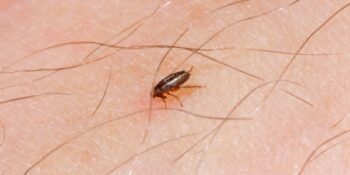
Particularly during the spring, late summer, and early fall on Long Island, ticks are out in full force, and your pets are prime targets! If the family dog spends time lounging in the grass or hiking outdoors by your side, it’s quite possible they’re going to end up with a tick or two.
Ticks, like mosquitoes, feed on animal and human blood, and will attach their mouthparts into the skin. After successfully attaching themselves, ticks will begin feeding on the blood of their host. Beyond the “ick” factor, ticks also put humans and animals at risk for several serious diseases, including Lyme Disease, Rocky Mountain Spotted Fever, and Ehrlichiosis, among others.
Tick Bite Symptoms in Dogs
Aside from signs of redness or irritation, one of the easiest ways to identify a tick problem on your dog is to simply check your dog’s body for ticks, which are usually large enough to be visible, especially if they’ve already taken a bite and their bodies are enlarged. Often, ticks will make their home around your dog’s head and neck, but no area is off limits for them—be sure to do a full body inspection, including harder-to-reach areas like inside your dog’s ears, inside their groin area, between their toes, and yes, under their front legs. Run your hands through their fur and your fingers along their skin. Ticks may resemble moles or warts, but if you look a little closer, you’ll realize those “moles” or “warts” have legs.
Dogs with longer or darker fur or thick undercoats can be especially difficult to check for ticks. With any dog, petting, bathing, and grooming your pooch regularly can help you learn what feels normal on their bodies and what is unusual.
Normal Tick Bites vs. Infected Tick Bites on Dogs
Tick bites on your dog are generally not life-threatening, however if you find a tick, the range of tick-borne diseases that can potentially affect your dog is cause for concern.
As mentioned, Lyme Disease affects both humans and dogs alike. Its symptoms can take weeks or even months before they’re apparent, but may include fever, loss of appetite, fatigue, stiff or swollen joints in your dog, or an unwillingness to walk.
Rocky Mountain Spotted Fever is another tick-borne disease, carried by multiple tick species present on Long Island, as well as many other parts of the country. Tick bite symptoms from this disease may include fever, loss of appetite, depression, vomiting, muscle pain or stiff joints, skin lesions, or neurological difficulties.
Among the range of canine tick-borne diseases, Ehrlichiosis, which is found all over the world, is extremely serious, and early diagnosis is essential. Its symptoms include fever, loss of appetite, watery eyes, runny nose, bloody mucus, enlarged lymph nodes, and breathing difficulties.
How to Treat a Tick Bite on a Dog
Ticks can transmit diseases in dogs in a matter of hours; removing them immediately is important. To remove a tick, follow these eight steps (and if you’re uncomfortable doing this yourself, give your veterinarian a call to remove it for you or walk you through the process):
- Put on a pair of disposable gloves.
- Hold your dog still.
- Using a pair of fine, sharp tweezers, grab the tick as closely to the skin as possible, and in one motion, carefully pull the tick straight up from the skin.
- Make sure you detached the entire tick. If you mistakenly leave behind its head or mouthparts, your dog could get an infection.
- Dispose of the tick safely (put it in a jar, douse it in rubbing alcohol, etc.)
- Disinfect the area on your dog’s skin.
- Give that pup a treat!
- Keep an eye on your dog over the next few days and weeks.
If your dog is on tick prevention medication (more on that later!), it’s possible they will still get a tick bite, but the tick will die and fall off without causing any harm.
Prevent Ticks from Biting Your Pets
Living in an area like Long Island, where ticks are more common, calls for some protective measures by dog owners to ensure your pet stays safe and tick-free. Maintaining a year-round, veterinarian-approved tick medication is the first step toward protecting your dog from tick bites. Checking your dog for ticks should also be part of your daily routine when your furry pal is spending a lot of time outside.
Beyond a regular tick medication for your dog, treating your yard with both granular and liquid materials is the single most effective way to reduce the tick population in your yard. Further protect your pets and prevent ticks—call (631/516) 864-6900 to schedule a tick control treatment for your yard today!





